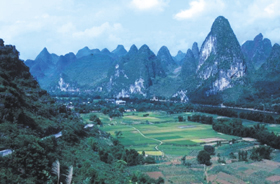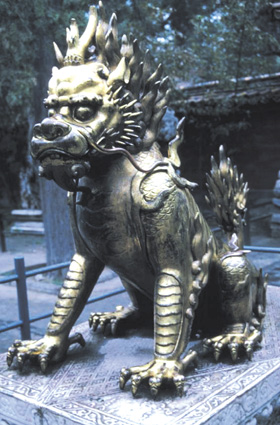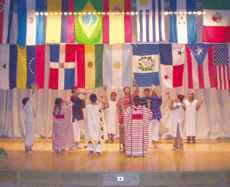Travels from Abroad: The Road to Xi’an

August 1, 2002
There are no atheists in foxholes or converted Russian planes. Imagine smoke seeping from the ceiling like some cheap B-movie space shuttle. Add in shuddering, squeaking, persistent beeping, and fighting with the smiling flight attendants about just where I could put my bag. Questionable ride aside, I was excited. From above, the dunes of the Gobi Desert resemble folds of skin and the clouds, pieces of lint. I felt as if I was soaring above a giant belly button.
The flight to Urumqi, a province in northwestern China, promised to be fascinating. From there, weheaded back to Xi’an via train, plane, car, etc. This area is home to a majority of Muslims living in China, as well as its largest minority tribe whom are known as Uighurs. Ethnically, they are closer to the Mongolians and the Kazaks. Their spoken language has roots closer to Turkish and their written language uses Arabic script. It is altogether fascinating to see what happenswhen a kaleidoscope of cultures meshes in one area.
Originally, the Uighurs started out as nomads, raising sheep, goats, and cattle, and have quite a tradition of hospitality. Although a majority settled down in the ninth and tenth centuries, some still roam throughout the mountains during spring, summer, and fall, pausing to settle into villages in the winter. Their homes are cone-topped, circle-shaped tents of animal hide sometimes plain but usually decorated with brightly painted designs or Arabic words. The inside is warm, with elaborately embroidered or woven rugs placed atop a wooden step where one not only sleeps but also eats and sits, shoeless. They are quite comfortable, with a removable top for ventilation if one wants to keep a fire burning.
The Uighurs themselves are made up of three distinctive subgroups. There are Tibetan Buddhist Uighurs who live near Tibet and are closely related to the Tibetans (language difference not withstanding), the Christian Uighurs who were converted several hundred years ago, and, of course, the Muslim Uighurs. Their differences mostly seem related to religion. The Muslims living in China seem to be a rather liberal sort. They will not touch pork yet they will drink beer. The women do not cover their hair either or wear loose clothing.
An interesting anecdote that our guide told us while wewere there had to dowith what he called a “relationship barometer.” Thegame is called “Girl Chases Boy.” In it, a girl will ask a boy to walk with her to some destination of their choice. He is allowed to say whatever he wants to her and she cannot reply, she can only listen. Once they reach wherever they were headed, they turn back. The girl has a whip with her and she chases himback fromwhence they came. If she likes him, she will merely wave the whip over her head. If she doesn’t, she can saywhat she wants and, ifso necessary, express her displeasure with a whip instead of words. This time, he has to keep his mouth shut and hopethat shetakes pity.
Urumqi is situated out near the Gobi Desert. Between the towering mountains and sloping sand dunes, it is incredible that anything could survive there. Yet a few miles west is a valley known for its wines and incredible produce. The province of Xinjiang is rich with melons of every different type and trellises overflowing with grapes. To think that a veritable Garden of Eden could prosper in such a harsh climate is nothing short of amazing. One odd feature: random mounds of earth rising out of pancake flat plains. When we went to ask our guide, he stated that they were bodies. Apparently, since there is so much uninhabitable land, people are allowed to bury their dead wherever they please, free of charge.
In a feat of engineering that involves the mountains and China’s version of the Napa Valley, the inhabitants built a series of wells 100 feet below sea level, along the sloping section of the plain, carrying fresh melted snow down to the flatlands. It was designed sometime around 300 years ago, making it possible for their descendants to survive and thrive. Most of these farmers do not use pesticides either; the produce is naturally large and retains its sweet flavor unlike a majority of the aesthetically pleasingbut tasteless fruits found in America. It is a rather extreme comparison but there is a definite difference in quality when chemicals and genetic engineering come into play.
Besides visiting the vineyards, I had a chance to see ruins over a thousand years old. The site that my father and I visited was one of two cities that were considered to be the starting point for the Silk Road. There is nothing left but abandoned monolithic structures and caves ravaged by the desert winds. One feels that no one has lived here for a very long time. It is eerie to wander through the remains of what was reputed to be a cultured and developed city. It makes me wonder just where our own cities will be in another millennium. The mule ride there was dusty with sand and silence, except for the occasional chatter in Uighur between our guide and the driver or the jingling bells of the beast’s harness.There were once beautiful paintings and frescoes adorning the inside of some of the remaining buildings. However, a Russian archaeologist stumbled onto the site and raided it before an American made off with the rest, some of which is kept at Harvard.
This was not to be thefirst case where this had happened.Further along in our trip, I would encounterthe man-made caves of Dunhuang, where 1,500-2,000 year old pictures and carvings of Buddha dwelt, looking as fresh as the day they werepainted.Yet again, the site was raided by European colonial powers (with more pieces resting in Harvard I might add). But is itthe lesser of thetwo evils to have pieces of your national heritage resting, well-taken care of, preserved, andguarded in properly funded, temperature-controlled environments owned by other countries? Or should they be returned to countries that can barely take care of themlet alonerestore and maintain them since they lack the funds? Artifacts like those areeasily stolenand destroyed from understaffed museums such as those.
I remember visiting the Temple ofHeavenly Peace and watching as people justclimbed theover the railingsprotecting the walls, in order to have a better look. We would no sooner think of taking potshots at Mount Rushmore or climbing up and sitting in Abe’s lap atthe Lincoln Memorial. When does it become an issue ofpride of ownership outweighing common sense and admitting that one cannot afford to take care of a historical treasure?Outright theft cannot be condoned nor can neglect. Finding the balance inthat particular ethical gray area tends to be elusive if not impossible.
So many questions and so few answers. The more I learn, the less I know. I am not so certain as I thought I was. The moral, cultural, and ethical issues that arise from traveling provide for a widening of perspective that is difficult to deal with sometimes. You know you’re a nerd when you’re philosophizing on what is supposed to be your vacation. At least I’ll never be bored. More will follow next issue in which I talk about Buddha, lakes, and surfing on sand dunes.






















































